Complete Solutions to EXAMPLE of chapter ELECTRIC CHARGES AND FIELDS of Class 12 book with complete answers and questions
| Class 12 | PHYSICS |
| Chapter | ELECTRIC CHARGES AND FIELDS |
| NCERT GUJARATI | EXAMPLE |
| Number Of Questions | 13 |
| Academic Year | 2023-24 |
How can you charge a metal sphere positively without touching it
02:26View SolutionIf `10^(9)` electrons move out of a body to another body every second how much time is required to get a total charge of 1 C on the other body
01:30View SolutionHow much positive and negative charge is there in a cup of water
02:43View SolutionColumb law for electrostatic force between two point charges and newton law for gravitational force between two the distance between the charges and masses respectively (a) compare the strength of these forces by determining the ratio of their magnitudes (i) for an electron and a proton and (ii) for two protons (b) estimate the acceleratons of electron and proton due to the electrical force oftheir mutual attarction when they are 1A `(=10^(-10) m)` a part `(m_(p)=1.67xx10^(27) kg m_(e )=9.11xx10^(-31) kg)`
07:10View SolutionA charged metallic sphere A is suspended by a nylon thread another charged metallic sphere b held by an insulating centers is 10 cm as shown in Fig. 1.7(a). The resulting repulsion of A is noted (for example, by shining a beam of light and measuring the deflection of its shadow on a screen). Spheres A and B are touched by uncharged spheres C and D respectively, as shown in Fig. 1.7(b). C and D are then removed and B is brought closer to A to a distance of 5.0 cm between their centers, as shown in Fig. 1.7(c). What is the expected repulsion of A on the basis of Coulomb’s law? Spheres A and C and spheres B and D have identical sizes. ignore the sizes of a and b in comparison to the separation between their centers
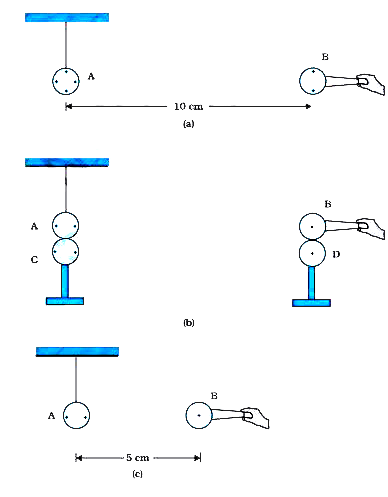 04:24View Solution
04:24View Solutionconsider three charges `q_(1),q_(2),q_(3)` each equal to q at the vertices of an equilateral triangle of side l what is the force on a charge Q placed at the centroid of the triangle
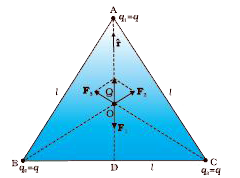 03:06View Solution
03:06View SolutionConsider the charges q, q and -q placed at vertices of an equilateral triangle as shown it figure. What is the force on each charge ?
07:14View SolutionAn electron falls throgh a distance of 1.5 cm in a uniform electric field of magnitude `2.0 xx10^(4) N c^(-1)` the direction of the field is reversed keeping its magnitude unchanged and a proton falls through the same distance compute the time of falls in each case contrast the situation with that of free fall under gravity
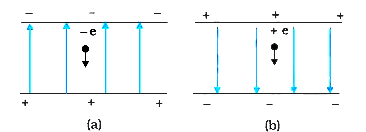 07:13View Solution
07:13View SolutionTwo point charges `q_(1)` and `q_(2)` of magnitude + `10^(-8)` c and `-10^(-8)` c respectively are placed 0.1 m apart calculate the electric fields at points a, b and c
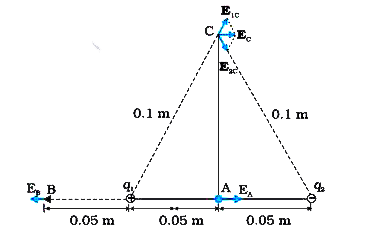 08:18View Solution
08:18View SolutionTow charges `pm10 mu` C are placed 5.0 mm apart determine the electric field at (a) a point p on the axis of the dipole 15 cm away from its centre o ont the side of the positive charge as (a) and (b) a point q 15 cm away from o on a line passing through o and normal to the axis of the dipole as
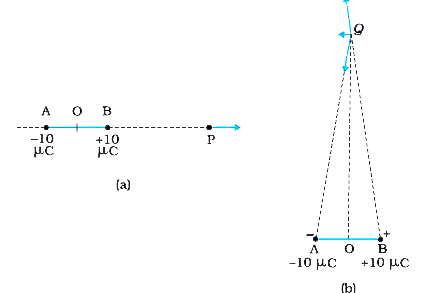 08:35View Solution
08:35View SolutionThe electric field components are `E_(x)=ax^(-1//2),E_(y)=E_(z)=0` in which a =800 N/C `m^(1//2)` calculate (a) the flux through the cube and (b) the charge within the cube asume that a=0.1 m
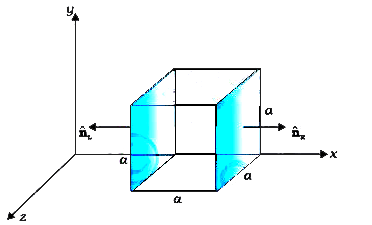 05:49View Solution
05:49View SolutionAn electric field is uniform and in the positive x direction for postive x and uniform with the same magnitude but in the negative x direction x it is given that E=200 I N/C length 20 cm and radius 5 cm has its centre at the origin and its axis x =-10 cm (a) what is the net ioutward flux through each flate face (b) what is the flux through the side of the cylinder (C ) what is the net outward flux thoght the cylinder (d) what is the net charge inside the cylinder
06:25View SolutionAn early model for an atom considered it to have a positively charged point nucleus of charge Ze, surrounded by a uniform density of negative charge up to a radius R. The atom as a whole is neutral. For this model, what is the electric field at a distance r from the nucleus ?
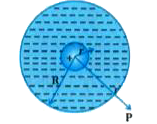 04:02View Solution
04:02View Solution
EXAMPLE questions and complete solutions for chapter ELECTRIC CHARGES AND FIELDS of NCERT PHYSICS(GUJRATI) of Class 12
